“Un Oeil” on the Occitanie: From Nîmes to Collioure and Back

A birthday break is what Patty Sadauskas and I needed…badly. And where better to take it than France? We deliberated over where and how, with too many choices, but wanted to be practical and reasonable without giving up much, if anything at all. The pieces of the puzzle came together without too much debate, knowing we both wanted to finally land at our respective second homes, Patty in Nîmes and me in Nice. The goal was to get to Nîmes in time for Patty’s birthday today. Tomorrow I’ll head to Nice for the rest of the month.
The TGV to Nîmes from Paris Friday was the usual “du gâteau,” where we easily picked up a car at Hertz (they comped us an automatic, maybe because we are American and the agent sensed we’d be happier) and began the trek southwest past Montpellier to the seaside towns of Sète and Agde, our stops along the way with Pèzenas as the final goal.

Our first stop, the seaside town of Sète
I’d been to these towns as long ago as 18 years when I led a tour to the Languedoc-Roussillon for International Living, but hadn’t been back since, focusing more of my attention on the southeast of France all these years, rather than the southwest. Sète was the first stop, a major port city bordered by the Etang de Thau, a biodiverse saltwater lagoon. It’s often called the “Venice of the Languedoc” for its canal network, and is lined with sandy beaches that I can only imagine draw big crowds during the summer vacation period.
In all honesty, Sète seemed a little tired. The buildings appear to be run-down and neglected; the people on the streets had a similar appearance, a little too tired and a little too poor, and the shops offered little of interest. It’s funny, but that’s how I remembered it 18 years ago, so perhaps it just hasn’t seen much of a boom for one reason or another. But that didn’t stop me from ordering a dozen raw oysters on the half shell for the tiny price of 12€. That’s a hint that it’s not the top of the tourism list for the area.

Dining on the Bouzigues Oysters in Sète
The oysters of “Bouzigues” from the Thau bassin have a serrated marbled shell and iodized freshness enhanced with a hint of hazelnut. They were briny, but delicious, and completely opposite in flavor from the Gulf of Mexico oysters I grew up with in New Orleans…but I’ve never met a raw oyster I didn’t like (except one that would make you ill, of course!).
Agde was just a passing phase, but a prettier one. From the little we saw, this town on the River Hèrault, just four kilometres from the Mediterranean where it connects to the Canal du Midi at the “L’Ecluse Ronde d’Agde” (Agde Round Lock), has a higher level of class than its seaside neighbor. We cruised the streets of Agde, but didn’t venture as far as “Cap d’Agde,” famous for its naturist site, two kilometers of beaches specifically for those who prefer to sunbathe (and do just about anything) in the nude. Maybe one of these days…!
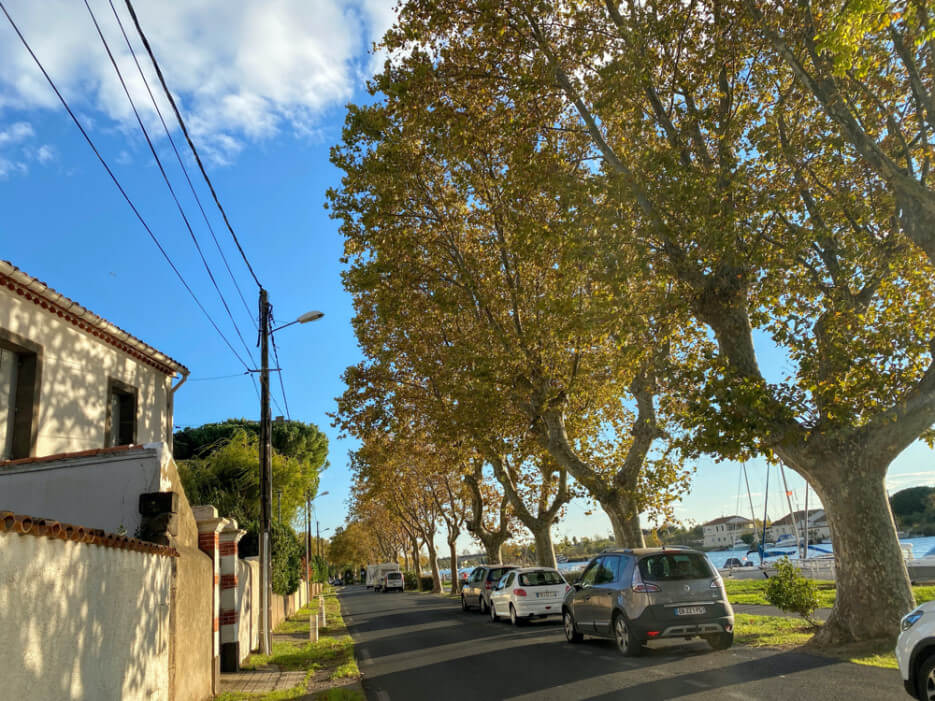
Another seaside town, Agde
We landed in Pèzenas just in time for sundown and scored big time with our hotel, Les Suites des Peyrat, booked using Booking.com. We were the only guests in the entire hotel. They gave us an entire floor to ourselves and one of their four best and luxurious rooms, a two-bedroom suite in an old Hotel Particulier at the edge of the historic center, with its own restaurant, “Chez Paul,” where we lazily took dinner and called it a night. We thought we had died and gone to heaven on a pauper’s budget.

Our hotel in Pèzenas, Les Suites des Peyrat
Early to rise, while lazing in our respective bedrooms on big fluffy pillows and mile-high beamed ceilings, we watched our newest House Hunters International episode, “Chapter Two in Paris,” Season 158, Episode 10, that aired six hours earlier in the U.S. “A busy dancer and choreographer (Jordan Washington) looks to start a new chapter and pursue a tourism degree in Paris. He’s looking for a furnished apartment with creature comforts that’s in the city, but his tight budget will be challenged in a pricey Paris market.” (Here’s a non-sanctioned Youtube.com link to watch it for a limited time only.)

Adrian and Jordan “on set” for Chapter Two in Paris
Pleased with the show, even though they edited out a few scenes I remembered thinking they’d likely use them, we set out for our morning in Pèzenas. Without realizing it, we landed there just in time for Saturday’s market day. It brought back memories of my time there 18 years ago, when our touring Americans were enamored by one of France’s typical open-air markets filled with flowers, fresh produce and some of the region’s best prepared dishes, such as the Petit Pâtè de Pèzenas, a speciality of the town the size and shape of a large cotton reel, little golden brown “pies” of a crispy pastry with a moist filling of lamb, fat, sugar, lemon peel, salt and pepper.
- Mouthwatering Petit Pâtè de Pèzenas at the village market
- A quiet village street in Pèzenas
The market stretches the length of the town center and is considered one of the best in the region. While we weren’t in the market for a basket-full of goodies, there is nothing quite like the sight, sounds and smells of a regional market in southern France. It reminded us why life in Pèzenas could be ideal. The neo-Roman town was a strategic point on the roads leading from Agde to Lodève, and Montagnac to Bèziers, and boasted of an intensive wine making activity with the right to organize general fairs and markets by the 16th and 17th-centuries. In the 18th-century, it became an important cloth producer, when great houses like the one we stayed in appeared on the scene. Today, the town’s stunning architecture is a reminder of its rich historic past.

Another view in Pèzenas
I wasn’t leaving the town until visiting the Jewish quarter, just two streets: rue de la Juiverie and rue des Litanies. The Jews settled there in 1298 (!!) coming from Spain, Portugal and Italy. They traded in old clothing (“schmatas” in Yiddish) and cattle, later adding to their expertise wool and linens. In 1332, a law imposed on the Jews crossing Pèzenas the right of “leude” (a grant, or a toll in a way), to pay a fee of 13 denarii (an ancient Roman silver coin, originally worth ten asses!) and get this…if the Jewess was pregnant, the fee was 26, twice the price! The Jewish families disappeared in 1394, during one of the last expulsions from France. (“C’est la vie des Juifs!”)

The Jewish quarter in Pèzenas, rue de la Juiverie
The town is elegant, beautiful and full of life. It’s no wonder so many Brits have made it home. It has a thriving expat community, more for the British than Americans, who have gravitated east toward the Riviera. It seems we should…and could change that if we set our minds to it!
The morning wandering around the city center and perusing the market was just enough taste of Pèzenas because we had a lot we wanted to accomplish on route to Collioure, our destination for the next two nights. My one request was to see the Canal du Midi again, after all these years, remembering it to be a highlight of the tour to the region I had remembered. I’d never seen a waterway as beautiful, where every single photo looked like an impressionist’s painting…lined in trees, the water calm and reflective, barges parked along the edge and a tranquility that felt infinite and seamless.
A short drive around the town of Bèziers, which wasn’t on our radar this time around, took us to the 9 Ecluses de Fonserannes, a flight of staircase locks on the Canal du Midi just on the edge of Bèziers. “They consist of eight oval-shaped lock chambers, characteristic of the Canal du Midi, and nine gates, which allow boats to be raised a height of 21.5 meters over a distance of 300 meters.” (Wikipedia.org)

The Canal du Midi on the Ecluses de Fonserannes

One of the locks on the Ecluses de Fonserannes
The big surprise of the excursion was the five-minute walk along a beautiful wood-slat path in the woods to reach the canal and the locks, at the base of which was an elegant and stunning glass-walled restaurant. It’s here we lunched very well at a moderate price, in the sun, backdropped by the canal’s magnificent scenery and greenery. It simply couldn’t have been more delightful and satisfying on every level.

The wooden path to the locks and the restaurant

A delightful, sunny restaurant on the Canal du Midi
Our biggest discovery, that happened by chance was getting a spectacular view of the Etang de Montady, of which we knew nothing about until Patty spotted it on Google’s satellite view of the area. The drained lagoon, once a freshwater wetland, located near Montady and Colombiers, midway between Bèziers and Narbonne, looks like a mark made by aliens. Instead we have the monks and wealthy landowners of Bèziers to thank for draining the lagoon to provide this extra bit of farmland for the then King of France who was finding solutions for his growing population. It dates back to the mid 13th-century.

The striking Etang de Montady seen from the Oppidum d’Ensèrune
To see it, one must climb (not by foot, but by car) to the Oppidum d’Ensèrune, an ancient hill-town (or oppidum) near the village of Nissan-lez-Ensèrune listed since 1935 as a Monument Historique by the French Ministry of Culture. The ruins and archeological site date back to the 6th-century BC. Up this hill, the view of the once-time lagoon (or pond), with its pie-shaped slivers butting up to an orb at the center, in stipes of greens and golds, is breathtaking. We wondered why we hadn’t heard of it before, surely it’s a sight that France would want to promote more, but it seemed more like our secret with very few visitors doing what we were doing.

A closer look at the landscape of the Etang de Montady
On route up the mountain, we came upon these strange holes in the ground that we later learned were sections of Cyclopean walls (a type of stonework found in Mycenaean architecture) and embedded silos dug, used as earthenware storage jars for grain and other agricultural products. The site wasn’t marked, nor is it easy to find more information about these strange formations. Why is this so unknown, we wondered?

The strange holes found at the Oppidum d’Ensèrune
Collioure wasn’t too far a trek down the non-toll roads, but the public parking was up on top of a wooded hill next to the Château Royal de Collioure. Fortunately the luggage rolled down the hill to our hotel, the Hôtel des Templiers, located in as perfect a spot in the quaint seaside town one can find, sandwiched between rue Colbert (number 5) and Quai de l’Amirautè (number 12). We were directed to the last, last, last room on the second floor with two balconies overlooking the quay with a perfect view of the Château. Down the long halls that zigzagged like a drunkard, were paintings upon paintings upon paintings, all of which were at least “not bad,” if not good or great.
- The Hôtel des Templiers (photo by Patty Sadauskas)
- Amazing artwork on the zigzagging walls of the hotel (photo by Patty Sadauskas)
As it turns out, owners, Renè Pous and his wife Pauline, who took over the restaurant and hotel from her mother’s tiny establishment once called La Maison Fontano, collected about 2,000 works of art by their friends, Matisse, Derain, Dufy, Maillol, Picasso, Survage and many others who paid for their meals with their works. The hotel is a museum in itself, and one could spend hours walking up and down the corridors, but what thrilled us most about the room was not only the bright floor-to-ceiling windows overlooking the quay, but the deep bathtub with serious water pressure! Patty and I ran to a small market to buy bubble bath and we took advantage of the mile-high foam it could produce a couple times a day.

Our room at the Hôtel des Templiers (photo by Patty Sadauskas)
Just at the Spanish border alludes to great tapas found all over Collioure. We found it at first try, at Chez Paco, whose menu seemed more authentic than most. By 7:30 p.m. all the tables were full, but we managed to sneak into two seats and relish the Bellota Iberian ham, enormous grilled shrimp, tortilla and “Pimientos de Padron.” It was clear it was a favorite of those “in the know” because the restaurants just next door were void of diners, while Paco was packing them in. We learned why the tapas was exceptionnel and we left not a bite, long after feeling stuffed to the gills.
Even though I zonked out at 9:30 p.m., the day seemed endless given how much we had done in so short a time. Patty and I realized that barely 30 hours had passed since I landed at the Nîmes station, but every moment had been filled with memorable pleasures of which we had taken hundreds of photos. Ten hours sleep was more than perfect to rise and shine early Sunday morning, head down to the cafè where I spotted a plug at a table at the window to have coffee and write (this nouvellettre®).
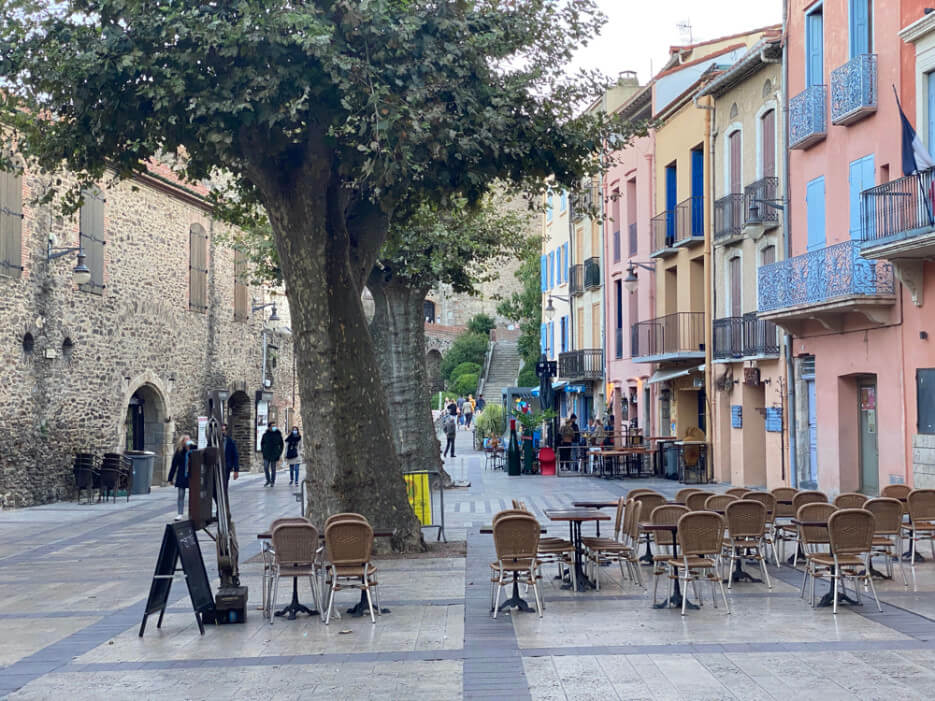
Sunday morning in Collioure
Before the Sunday market closed at 1 p.m., we closed up our laptops and headed out for a Sunday stroll toward the open-air market when we came upon a boutique with a dress on a mannequin out front that reminded us of the patterns of the Etang de Montady. Inside “Atelier Lestoutemps” we found the most amazing hand-crafted clothing, artworks and accessories, all the product of the woman inside, Bernadette Chaix. I tried on an incredible black wool coat, stitched and constructed in the most unusual patterns and shapes that was a work of art disguised as a coat. In spite of its pricy tag, 1,000€, I had to try it on, falling madly in love with it.

The lively Sunday Market in Collioure
I asked Madame Chaix if I could have a photo taken of me in the coat, to which she refused. “Si vous l’achetez, madame, vous pouvez prendre la photo!” (If you buy it, madame, you can take the photo.) I explained that I have a lot of followers who would love to know about the boutique. That made no difference. In fact, that’s the last thing she wanted, for fear of being copied.
- Strolling through Collioure
- Madame Chaix’s Atelier Lestoutemps
That was Culture Clash with a Capital “C” which led to an interesting conversation. I pointed out to her that it was a question of “promotion” vs “protection.” Wouldn’t she want the world to know about her beautiful art? Doesn’t she realize that imitation is the sincerest form of flattery and that the more people who know about it, the more valuable it becomes…that no matter how many copy-cats there are, her work will always be the original? Wouldn’t she want to sell her work and have it be adored? (I did not point out that she could also make more money, knowing that’s exactly what would turn her off to my ideas.)

Madame Chaix’s artistic designs
“Non, madame.” She was very happy the way it was, working out of her tiny space in the town of Collioure, selling bits and pieces to tourists who discover her and no more. She has no website, just an out-of-date Facebook page and strangely enough, she sewed…machine stitched…her business card to our packages so they couldn’t be taken off without destroying them. (Patty bought a drawing to frame and hang and I bought a shoulder bag of a similar design as the coat.) “Tant pis” (too bad) for Madame Chaix, because like it or not, word is already out about her amazing creations fit for the Paris runway…especially if I have my way!
Just next door to the Atelier Lestoutemps was a small shoe shop too busy with customers to do much more than take a photo of the funniest slippers I’ve ever seen, each foot sporting a photo of a Chasidic rabbi. It was tough to tell if they were designed for men or women, and as much as I really wanted a pair, just for the joke of it, I wondered if I could really live with these two religious gentlemen on my feet whose doctrine is largely anti-feminist. The answer is “no.”

Rabbinical slippers? Non!
The Quai de l’Amirautè is lined with restaurants and cafès where we lunched copiously on more Iberian ham and mussels, then walked it off with a stroll around the castle along the water’s edge. Collioure stole our hearts for its beauty and character, but what I’ll remember most from our 36 hours in the Franco-Spanish town will be a bath tub with mile-high foam, the sound of the thousands of birds chirping from the trees opposite our balconies and Bernadette’s need to protect her art from duplication.

The delightful Quai de l’Amirautè
Today we high tail it back to Nîmes, drop the rental car and celebrate Patty’s birthday.
A la prochaine…in Nice as of tomorrow…
 Adrian Leeds
Adrian Leeds
Adrian Leeds Group
(Enjoying the enormous grilled shrimp at Chez Paco)
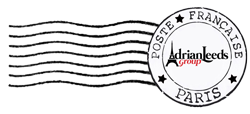
P.S. If you are considering a property purchase in France, don’t do it lightly. Let us help you make the smartest decisions to ensure you make the best investment you can. Contact us to learn more!
1 Comment
Leave a Comment
To read more, click the links below.


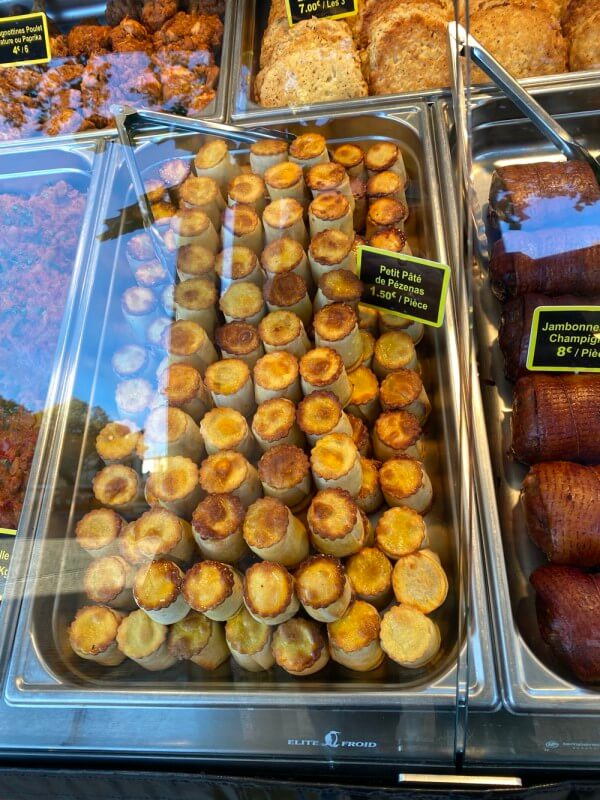



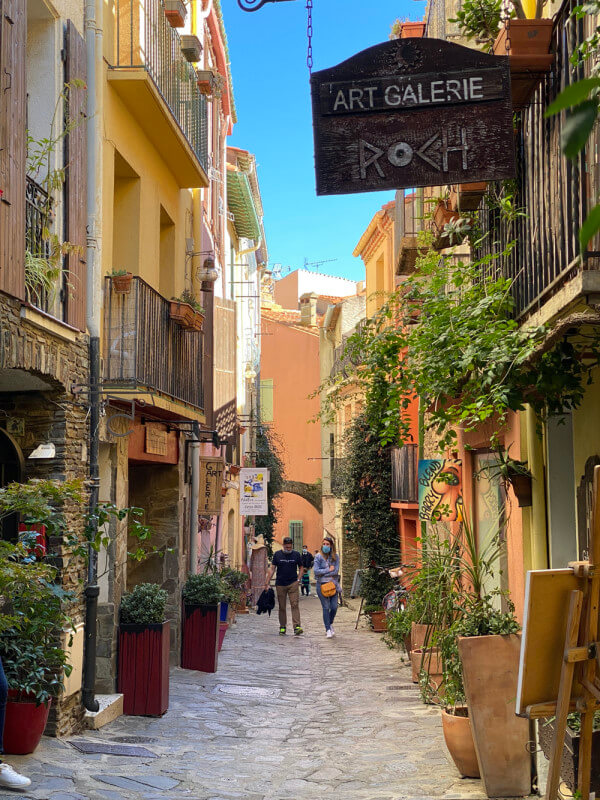






Great article.
Love your show on House Hunters International.